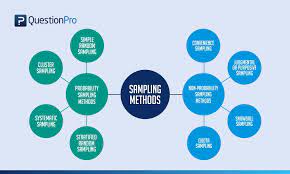Sampling is a process used in statistical analysis in which a predetermined number of observations are taken from a larger population. The methodology used to sample from a larger population depends on the type of analysis being performed, but it may include simple random sampling or systematic sampling.
In statistics, quality assurance, and survey methodology, sampling is the selection of a subset (a statistical sample) of individuals from within a statistical population to estimate characteristics of the whole population. Statisticians attempt to collect samples that are representative of the population in question. Sampling has lower costs and faster data collection than measuring the entire population and can provide insights in cases where it is infeasible to sample an entire population.
Each observation measures one or more properties (such as weight, location, color) of independent objects or individuals. In survey sampling, weights can be applied to the data to adjust for the sample design, particularly in stratified sampling. Results from probability theory and statistical theory are employed to guide the practice. In business and medical research, sampling is widely used for gathering information about a population. Acceptance sampling is use to determine if a production lot of material meets the governing specifications.
What is the purpose of sampling?
A sample refers to a smaller, manageable version of a larger group. It is a subset containing the characteristics of a larger population. Samples are use in statistical testing when population sizes are too large for the test to include all possible members or observations.
What are the benefits of sampling?
- Low cost of sampling.
- Less time consuming.
- Scope of sampling is high.
- Accuracy of data is high.
- Organization of convenience.
- Intensive and exhaustive data.
- Suitable in limited resources.
- Better rapport.
What are the characteristics of sampling?
In this, we assume that samples are draw from the population and sample means and population means are equal. A population can defined as a whole that includes all items and characteristics of the research taken into study.
What is the importance in research in education?
Most research studies in education require some form of sample. Because you can’t always study everyone or everything, it means that you only study part of a larger group and (hopefully) are still able to draw meaningful conclusions.
What is the use and application in research?
This has lower costs and faster data collection than measuring the entire population and can provide insights in cases where it is infeasible to sample an entire population. In business and medical research, it is widely use for gathering information about a population.
Where is sampling used in real life?
Real world examples of simple random method include: At a birthday party, teams for a game are chooses by putting everyone’s name into a jar, and then choosing the names at random for each team. On an assembly line, each employee is assign to a random number using computer software.
What are 5 reasons we use a sample to study a population?
- Save Time.
- Save Money.
- Collect Richer Data.
- Academic Research.
- Market Research.
- Public Polling.
- User Testing.
What are the types of samples?
- Simple random.
- Systematic.
- Stratified .
- Cluster .
Which sampling method is best?
Simple random : One of the best probability techniques that helps in saving time and resources, is the Simple Random method. It is a reliable method of obtaining information where every single member of a population is choose randomly, merely by chance.





